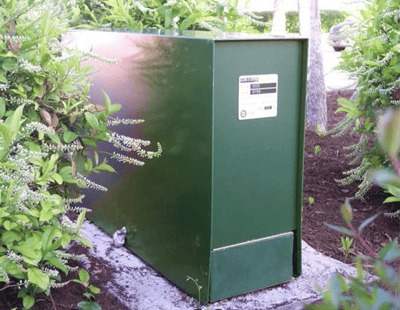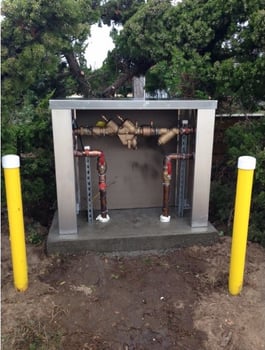This page will teach you everything you need to know about backflow enclosures & why they're protection for keeping backflow prevention devices safe.
-
1Contact Information
-
2Additional Details
This page will teach you everything you need to know about backflow enclosures & why they're protection for keeping backflow prevention devices safe.
 There is no longer any denying the importance of using a backflow cover. Between extreme heat and cold and erratic severe weather, let alone the risk of theft or vandalism, leaving a backflow preventer exposed similar to ones in backflow cages is asking for trouble, threatening loss, injury, property damage and the environment.
There is no longer any denying the importance of using a backflow cover. Between extreme heat and cold and erratic severe weather, let alone the risk of theft or vandalism, leaving a backflow preventer exposed similar to ones in backflow cages is asking for trouble, threatening loss, injury, property damage and the environment.
In response, water authorities around the country are beginning to adopt policies requiring the outdoor installation of preventers as well as the use of insulated backflow enclosures, instead of traditional installations indoors or underground in a vault.
They’re thinking outside the vault. You should, too.
 As the name suggests, a backflow preventer is a device that keeps potentially contaminated water from flowing back into source lines. There are two predominant forms of backflow preventers: the double-check (DC) valve and the reduced pressure zone (RPZ) valve. The RPZ is preferred in almost every instance.
As the name suggests, a backflow preventer is a device that keeps potentially contaminated water from flowing back into source lines. There are two predominant forms of backflow preventers: the double-check (DC) valve and the reduced pressure zone (RPZ) valve. The RPZ is preferred in almost every instance..jpg?width=400&height=195&name=backflow%20enclosure%200006%20(1).jpg) Safe-T-Cover is the industry leader in backflow preventer enclosures. Manufactured with marine-grade aluminum with applied insulation, California redwood bracing and rated to the ASSE 1060 standard, our modular enclosures are built to last, and designed to most major OEM designs, such as Watts, Zurn and FEBCO. We also offer custom enclosure designs, many of which can be turned around and on your site in four weeks.
Safe-T-Cover is the industry leader in backflow preventer enclosures. Manufactured with marine-grade aluminum with applied insulation, California redwood bracing and rated to the ASSE 1060 standard, our modular enclosures are built to last, and designed to most major OEM designs, such as Watts, Zurn and FEBCO. We also offer custom enclosure designs, many of which can be turned around and on your site in four weeks.
Yes! In a growing number of jurisdictions, it’s not just recommended, it’s required by law.

A backflow preventer can be covered by an insulated bag, fake rock, fiberglass covering, a steel cage or an aluminum enclosure. For any number of reasons, an aluminum enclosure is the best choice for protecting your waterworks equipment and the water supply.

Your backflow preventer should be covered all year long, but definitely insulated and heated, protecting from freeze in the winter.

You should have a backflow enclosure for the following reasons:
Compliance: Many municipalities require the installation of backflow preventer enclosures to comply with local codes and regulations. Failure to comply with these regulations can result in fines, legal liability and risk to public health.
Protection: A backflow enclosure protects backflow prevention assemblies from physical damage, vandalism, theft and exposure to the elements. It ensures that the equipment functions properly, maintaining water supply safety.
Convenience: Backflow enclosures provide convenient access for maintenance, inspection and testing of backflow preventer devices. They also make it easier to locate and identify the assemblies in case of emergency or repair.
Durability: Backflow enclosures are typically made of sturdy materials such as steel or aluminum and are designed to withstand extreme weather conditions, wear and tear, and tampering. They are built to last for many years and require minimal maintenance. A rugged aluminum enclosure is as important an investment as it is in your backflow prevention equipment itself.
Using a backflow enclosure is a practical and necessary solution to protect the water supply, comply with regulations, ensure convenience and durability, and enhance the aesthetics of the property.

Back pressure valves are sometimes confused with backflow preventers. Backflow preventers are designed to prevent the 2 types of backflow in a plumbing or waterworks system, back-siphonage and back-pressure. Usually when someone refers specifically to a "back pressure valve", they are referring to the pump or industrial industry.

Fake rocks are decorative plastic, while bags provide inadequate protection from freezing and theft. We’re biased, of course, but objectively speaking, there just aren’t any good reasons to settle for fake rocks or a easily-destroyed bag.

Regardless of where you are in the US, you can’t assume freezing temperatures won’t reach you. We recommend having a slab-mounted heater anywhere ready to go to protect your backflow equipment if and when a winter blast comes your way.
Looking for a custom quote? Have questions?
Fill out the form via the button below and we will get back to you as quickly as possible.
We're in the office 8am-4pm Central Time, Monday through Friday.

© 2026 by Hydrocowl, Inc. All Rights Reserved.
Terms & Conditions | Privacy Policy